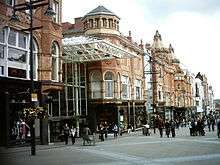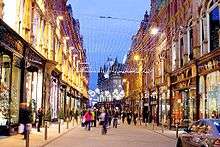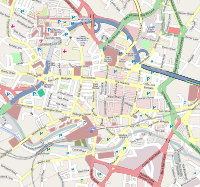Leeds city centre
Coordinates: 53°47′59″N 1°32′54″W / 53.7998°N 1.5482°W
Leeds city centre is the city centre of Leeds, England. It is within the Leeds Central parliamentary constituency, represented by Hilary Benn as MP since a by-election in 1999. The term central Leeds is often used to describe the city centre, although it refers to a wider area within the Inner Ring Road. While the city centre has no formal definition, it is roughly bounded by the Inner Ring Road to the north and the River Aire to the south and can be divided into four quarters.
Quarters
Civic Quarter

The Civic Quarter is the area roughly north of the Headrow and is predominantly home to a number of Victorian buildings. Prominent landmarks include the Leeds Magistrates' and Crown Courts, the City Library and City Gallery, and Leeds Town Hall, which was completed in 1858 and opened by Queen Victoria. Queen Square is also found here. The city's largest hospital, the Leeds General Infirmary, has been operating here since 1869.
Behind Leeds Town Hall are Millennium Square and Leeds Civic Hall. Millennium Square was a flagship project to mark the year 2000 and hosts regular concerts, with past performers including the Kaiser Chiefs, Bridewell Taxis' HARD-Fi, Fall Out Boy and Embrace. Leeds Civic Hall was opened in 1933 by King George V and is home to the Lord Mayor's Room and the council chambers. Many barristers' chambers and solicitors' offices are found here because of the close proximity to the courts. Also nearby are Leeds Metropolitan University, the University of Leeds, Leeds College of Art and the Park Lane and Technology campuses of Leeds City College
Shopping Quarter

The Shopping Quarter extends south from the Headrow to Boar Lane and contains many of the city's largest shops including major international chains such as Marks & Spencer (founded as a small stall at the city market in 1884). The Corn Exchange was home to many independent shops, until they were mostly evicted in 2007 by the building owners, Zurich.
_002.jpg)
Opened 21 March 2013,[1] the new Trinity Leeds shopping centre had a surge of 130,000 people enter its doors on the first day of opening. Costing £350m[1] and creating 3,000 jobs,[1] this was a major development for Leeds. It was the only major retail development to open in the UK in 2013.[1] It covers 1,000,000 sq ft (92,900 sq m)[1] with key anchor stores being Topman and M&S.[2] Other stores in the centre include Apple, River Island, Next, Hollister, H&M, Primark, Everyman, Conran Restaurants and Mango. It has a capacity for 120 shops and numerous pop-up shops.

Department stores in Leeds which have historically included Lewis's, which became Allders in 1996 and latterly closed in 2005, Schofields which was taken over by House of Fraser in 1988 and closed in 1996, the Co-op which closed in the mid 1990s, Littlewoods which closed in the late 1990s and is now occupied by Zara and H&M, C&A which closed in 2001 and is currently occupied by Next Clearance (until demolition for construction of the Trinity Quarter) and Marshall & Snelgrove which became part of Debenhams and closed in the 1970s and lies of the site of Lloyds TSB on Park Row have disappeared but currently department stores include Debenhams (historically known as Matthias Robinson), Harvey Nichols (which when opened in 1996 became the first branch outside London), Marks and Spencer, BHS and House of Fraser (formerly a Woolworths, it temporarily became premises for Schofields and latterly became Rackhams before becoming House of Fraser in 1996).

Most streets in the Shopping Quarter are connected to Briggate, one of the main shopping streets, home to several national and international food chains, like McDonald's, Burger King and Nando's, and international shopping chains, including Zara. Off Briggate are several of Leeds' famous shopping arcades, such as the Thornton Arcade and the Victoria Quarter. Briggate was fully pedestrianised in 1996 and connected the two previously pedestrian areas either side of it. Other shopping attractions include the Corn Exchange, Leeds Kirkgate Market, Granary Wharfe, Leeds Shopping Plaza, Headrow Shopping Centre, The Light, the St Johns Centre, the Merrion Centre and Crown Point Retail park which lies half a mile away from the retail core. In addition, two further shopping centres are proposed, namely the Eastgate Quarters which is to include a John Lewis department store and Trinity Quarter.
Cultural Quarter

The Cultural Quarter is situated in the east of the city centre. Landmarks here include the BBC building, which moved from Woodhouse Lane just north of the city centre in August 2004, the West Yorkshire Playhouse, which opened in March 1990, and the Leeds College of Music, which moved to its current location in 1997.
The Cultural Quarter is also where the Royal Armouries Museum (opened in 1996 when the collection was transferred north from its previous location, the Tower of London) can be found, although it is more in the south of the city centre than it is the east. The building, designed by architect Derek Walker, was built at a cost of £42.5 million and completed in two years, and has since become one of the city's major tourist attractions.
Clarence Dock also lies on the fringes of the Cultural Quarter.
Financial Quarter



The Financial Quarter is bounded by Park Row to the East, Leeds Inner Ring Road to the west, The Headrow to the north and Wellington Street to the south. It is centred on the Georgian Park Square, one of the green spaces in Leeds city centre. The City Centre Loop passes through the quarter, using City Square, Quebec Street, King Street and East Parade. Leeds Law School is located at Cloth Hall Court. Major names can be found in the financial quarter such as Aviva and The Bank of England.
Infirmary Street is a major bus interchange in the financial district. The railway station which lies on the fringes of the financial district also has a bus interchange.
In the areas around Park Square, some of Leeds' finest Georgian architecture can be seen; the relative age and small size of the buildings in this part of the financial quarter make it popular with smaller companies, in particular small legal and clerical companies such as solicitors and management consultants.
Although its principal function is as a financial quarter, there are a number of restaurants and hotels. Hotel Metropole, Residence 6, Quebecs Hotel are some of the hotels. Est Est Est, Restaurant Bar and Grill, Wagamama, Pitcher and Piano, Slug and Lettuce and Loch Fyne Seafood are some of the restaurants, mainly around the East Parade and Park Row areas. Greek Street houses many of the bars in the financial quarter, which are usually open later than the restaurants. The independent retail and food scenes have been growing in recent years.
Financial companies with major offices in the city centre
Within the Financial Quarter
Elsewhere in the city centre
Outside of the city centre, First Direct have their headquarters at Stourton, while HBOS have major offices in Lovell Park.
Leeds Lights
Each Christmas the streets of Leeds city centre are decorated with a variety of Christmas lights. The widely publicised switch-on' ceremony is in early November, when a celebrity flicks the switch to illuminate the decorations at Victoria Gardens and usually attracts tens-of-thousands of people to the turning on ceremony. When Leeds Lights were first established in 1983, the switch on was held on the 4th Thursday of November, however it has since been brought forward. The illuminations are renowned as being the largest display in the United Kingdom, spanning over 13 miles of city centre streets and using over 2 million low energy light bulbs.
Leeds is notable for designing, manufacturing and maintaining its own Christmas Light motifs. Its workshop began as a place to provide people with disabilities some employment opportunities. Its workshop has had several locations, beginning in a temporary location near Chapeltown Road, then to the old disused Whitbread Brewery site at Kirkstall and from 1993 to the present Seacroft location. Leeds City Council was the only local authority to do this for some years but now a small number have followed Leeds Lights example in preparing their own displays where as most other councils buy in their lights and services. The lights are repaired and pressure cleaned annually at the Leeds Lights workshop in Seacroft throughout the year. 80,000 coloured lamps are stored at the workshop, and 2000m of coloured rope light are used. A team of 14 works all year round producing the display. From October–January, a team of 9 works to erect the lights ready for the switch on in early November, before removing the lights after Christmas.
In recent years, commercial advertising has been permitted on some of the lights, such as The Headrow's champagne bottle lights.
Celebrities who turned on the Leeds Christmas lights
- 2015 — Alex Peel
- 2014 — Sam Bailey and G4[3]
- 2013 — Gabriella Cilmi and The Vamps
- 2012 — Jonathan Brownlee
- 2011 — Matt Cardle
- 2010 — McFly, Shayne Ward (Miley Cyrus)
- 2009 — Pixie Lott (late replacement for Alexandra Burke), Mini Viva, Girls Can't Catch with guest appearances from Lorraine Kelly and members of LUFC and Leeds Rhinos.
- 2008 — Leon Jackson, Alesha Dixon, Simon Webbe and Same Difference.
- 2007 — Shayne Ward, Dick and Dom, Chico.
- 2006 — McFly (Gaynor Faye and Jane Tomlinson also appeared)
- 2005 — Rachel Stevens and the Lovebites with Nicki Chapman presenting.
- 2004 — Chris Moyles and Girls Aloud
- 2003 — Phill Jupitus
- 2002 — Ainsley Harriott
- 2001 — Vinnie Jones and Lucas Radebe
- 2000 — Mark Lamarr, Dave Benson-Phillips, Harry Kewell, Sheree Murphy and Billie Piper
- 1998 — Mel B and Les Dennis
- 1997 — Rolf Harris and Rod Hull & Emu
- 1996 — Dale Winton
- 1995 — Little and Large, Right Said Fred and PJ and Duncan
- 1994 — Paul Daniels
- 1993 — Noel Edmonds & Mr Blobby
- 1992 — Sonia
- 1989 — Melanie Hill
- 1986 — Native American Joe Sierra
- 1983 — Russ Abbot
Transport
Rail


Leeds city centre is served by Leeds railway station. The station is one of 17 in Great Britain to be managed by Network Rail. It is the busiest English station outside London, and the UK's second busiest station outside London after Glasgow Central.[4] The station serves national, regional and suburban railway services.
Air
The city centre is served by Leeds Bradford International Airport. This is situated in Yeadon approximately seven miles North West of the city centre. The city centre is linked to the airport by the 757 Metro bus service. The airport serves major European destinations as well as many further afield.
Road
Traffic passing past Leeds city centre is diverted away from the main areas by the Leeds Inner Ring Road, an urban motorway passing the East, North and West of the city centre. Much of the Inner Ring Road is in tunnels so not visible to passing pedestrians. All major routes into Leeds head towards the city centre. The city centre is served by the M621 motorway.
Buses
The most notable bus service within central Leeds is the FreeCityBus service operated by First Leeds and funded by Metro. This service runs every few minutes in a clockwise direction around the city centre. It serves major transport interchanges and both universities as well as the main shopping and financial districts. There have been calls for a second FreeCityBus to serve emerging business, leisure and residential districts in the southern part of central Leeds.
Leeds city centre has its main bus station in the east of the city. However, as a rule only buses heading out of the City of Leeds and National Express services use it. Local First Leeds buses use stops on the city streets, or a number of smaller bus stations, referred to as bus points, at Bond Street, Infirmary Street, Leeds railway station and the Corn Exchange.


Location grid
 |
Woodhouse |  | ||
| Armley | |
Cross Green | ||
| ||||
| | ||||
| Holbeck |
References
- 1 2 3 4 5 "Trinity Leeds shopping and leisure complex opens". BBC. 2013-03-21. Retrieved 2013-06-27.
- ↑ http://www.landsecuritiesretail.com/portfolio/Trinity-Leeds
- ↑ "Leeds Lights Switch-On 2014". Leeds City Council. 2014-11-13. Retrieved 2015-06-26.
- ↑ http://www.rail-reg.gov.uk/upload/xls/station-usage-2006-07.xls
Further reading
- Burt S. and Grady K. (2002 – 2nd edition) The Illustrated History of Leeds, Breedon Books, Derby
- Fraser D. (ed.) (1980) A History of Modern Leeds, Manchester University Press, Manchester
- Unsworth R. and Stillwell J. (eds.) (2004) Twenty-First Century Leeds: Geographies of a Regional City, Leeds University Press, Leeds; Sixteen Chapters about the Contemporary City; 160 maps, many photos
- Wrathmell S. (2005), Leeds, Pevsner Architectural Guides, Yale University Press, London
External links
| Wikimedia Commons has media related to Leeds City Centre. |
| Wikivoyage has a travel guide for Central Leeds. |
- 'Leeds Initiative' Leeds Initiative city partnership.
- Leeds City Council
- 'Leeds, Live it, Love it' Official city website, for visitors, business, students and residents.
- Leeds Local History Wiki Add your memories of Leeds.
